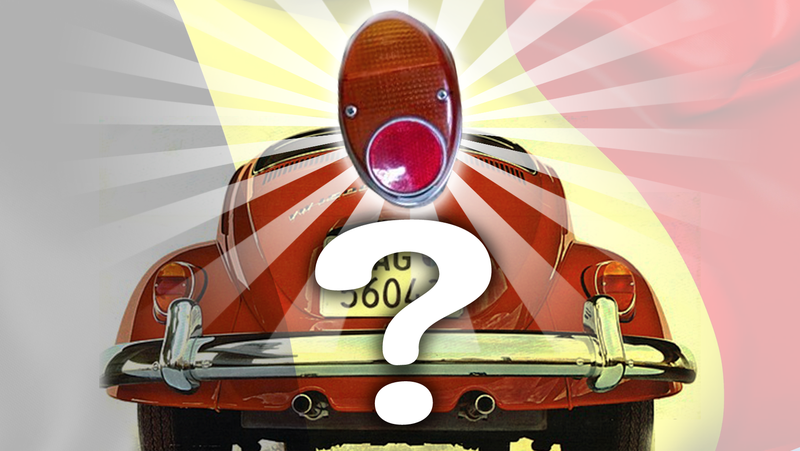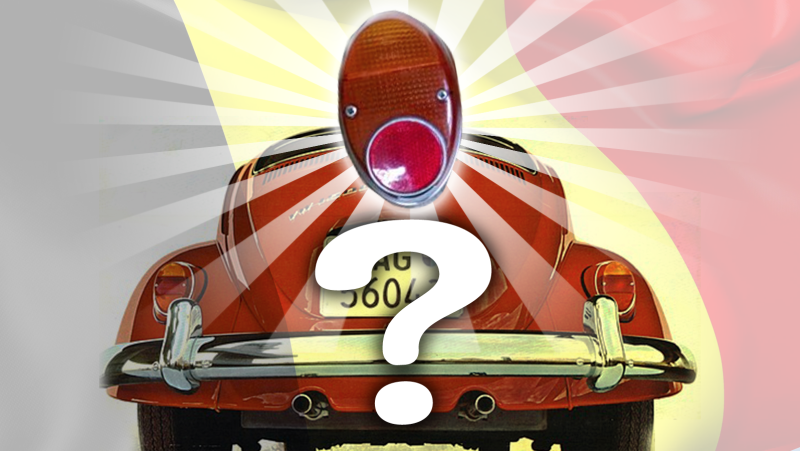
I’m sure there’s many of you out there laboring under the mistaken belief that, regarding the subject of Volkswagen Beetle taillights, everything that can be known, is known. While I once may have believed this myself, I now no longer am able to believe this is true. I know this from past experiences, and even current ones, as this ad for some Belgian tail lights drives home.
Just for a bit of background on the grand, very important subject of Beetle taillight evolution, here’s a chart I made the last time a formerly unknown taillight variant came to my attention:

Now, let’s focus on the era of these particular lights, so you know why they’re so weird: in 1962, Volkswagen decided that maybe having tiny little oval taillights the size of a baby’s fist might not be the best thing for nighttime visibility, so they designed an all-new taillight unit for 1962: a larger oval unit, divided into three sections: a top indicator section (amber everywhere but in the U.S., where it was red), a middle brake/taillight section, and a lower reflector section.
I had thought that these lights were used pretty much globally, at least until I saw this ad in the Samba:

Advertisement
Woah woah woah. What the hell am I looking at, here? Belgium-only taillights? And they have a big, round reflector on an all-amber body? What the hell is this sorcery from the People of the Waffles?
Closer inspection of the pictures just bring up more questions than answers.

Advertisement
The upper and middle sections are amber—hell, the whole plastic lens is amber, something that as far as I know Hella (the original maker of VW lamps) never produced. And it’s not like that red reflector is just glued onto the plastic lens—it’s actually inset into a hole in the amber plastic main lens, presumably so a bulb could shine through it, redly? Maybe?
I’m really baffled here, so I reached out to a Belgian Volkswagen expert, Bob Van Heyst, who runs the Belgian BBT Volkswagen parts company. Here’s what he told me:
“As far as I know they’re aftermarket taillights, we need in Belgium always reflectors on a car, with Emarks (like kind a DOT regulation for you) so aftermarket companies trioed always for the cheapest way…J gluing an bicycle reflector on a plain lens, was cheaper as homologate a complete lens…”
Advertisement
Now, as much of an ass as it make me seem to be, I have to disagree with the actual expert here, because those lenses are clearly not just glued on, they’re actually manufactured to specifically hold that round reflector, and even if they were, the plastic lens itself is all-amber, a type Hella never produced, at least as far as I know.
And, the regular, rest-of-the-world lens of this era had a built-in reflector! So why would this be needed?
Perhaps the standard reflector was too small, and it took something like this to meet the minimum area? Maybe? Was this a factory item? They did build CKD (completely knocked down) Beetles in Belgium via a company called D’leteren, but so far I can’t find any pictures of Belgian-market Beetles with these lights.
Advertisement

The ones I’ve found just have regular rear lamps.
So, what the hell are these? They don’t seem like they’re home-made, mostly because of the all-amber lens section, which I don’t think the average Belgian Beetle-owner was going to just cast their own plastic lenses in their kitchen ovens.
Advertisement
I reached out to the seller, but have yet to hear back. As soon as I do, if there’s some fascinating insight, I’ll update.
The important takeaway here, though, is that taillight study is a rich, and fascinating discipline, and ever capable of surprising you. It’s why so many taillight researchers go mad, and why it’s such a thrill for those that can ride that ragged, shining red line.















